 |
Scientific nameBracon (Habrobracon) brevicornis (Wesmael) (=Bracon brevicornis (Wesmael))
Taxonomic positionHymenoptera: Braconidae: Braconinae
DiagnosisLength of fore wing 1.9-2.6 mm, of body 1.8-2.6 mm. Colour is very variable: body nearly completely yellowish brown to largely dark brown or black, with frons, orbits, vertex anteriorly, face laterally, pronotum dorsally, notaulic area, scutellum (except usually medioanteriorly), first tergite (except medioposteriorly) and following tergites laterally pale yellowish; basal two-thirds of wings more or less infuscate, remainder of wings subhyaline, but sometimes infuscate apically; pterostigma rather dark brown, with sometimes a (faint) pale basal spot. Antenna of female (Fig. 1-2) with 15-18 segments,
submoniliform, slightly longer than length of head and mesosoma combined; antenna of male 22-27-segmented
(Fig. 3). Setae of vertex comparatively adpressed, mostly not reaching above upper level of posterior ocellus (Fig. 4); clypeus nearly flat to convex (Fig. 4); clypeus, face and frons finely granulate; setae of face rather short; vertex mainly smooth; mesoscutum largely setose, shiny, smooth; scutellar sulcus
narrow and distinctly crenulate; vein 3-SR of fore wing 1.2-1.8 times vein r, veins 1-SR and 3-SR short, but 1-SR may be rather long (Fig. 5); marginal cell of fore wing medium-sized, ending distinctly removed from apex of wing (Fig. 5); tarsal claws with small acute lobe; propodeum superficially granulate;
length of first tergite about 0.8 times its apical width, its surface smooth; dorsolateral carinae of first tergite absent; second tergite without mediobasal area; second metasomal suture rather deep, nearly straight and finely crenulate; second to seventh segments superficially granulate, shiny; length of ovipositor sheath 0.20-0.29 times fore wing and about twice length of first tergite (modified from van Achterberg & Walker, 1998).
This species is closely related to another common species, Bracon (Habrobracon) hebetor (Say), from which it can be identified by the following characters: Antenna of female with 15-18 segments, slightly longer than length of head and mesosoma combined; antennal segments of level of posterior ocellus; vein 3-SR of fore wing 1.2-1.8 times vein r.  Fig. 1-3. Adult female, lateral view; 2. Female antenna, apical segments; 3. Male antenna Fig. 1-3. Adult female, lateral view; 2. Female antenna, apical segments; 3. Male antenna Fig. 4. Head, showing setae on vertex; clypeus, lateral margin Fig. 4. Head, showing setae on vertex; clypeus, lateral margin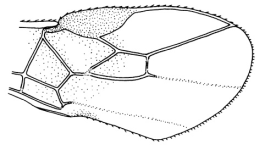 Fig. 5. Fore wing venation Fig. 5. Fore wing venation
Images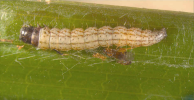
 
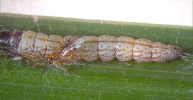 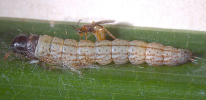
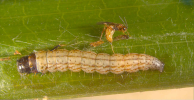 Bracon brevicornis parasitising the larva of Opisina arenosella (Walker) 
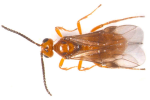 Adult female - dorsal view Adult female - dorsal view
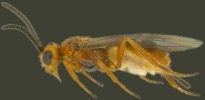 Adult - dorsal & lateral view Adult - dorsal & lateral view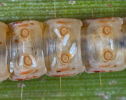

 Eggs of B. brevicornis on the larva of Opisina arenosella Eggs of B. brevicornis on the larva of Opisina arenosella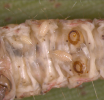
 Early instar larvae of B. brevicornis on O. arenosella Early instar larvae of B. brevicornis on O. arenosella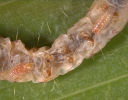
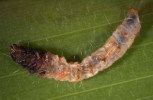 Fully grown larva of B. brevicornis feeding on O. arenosella Fully grown larva of B. brevicornis feeding on O. arenosella
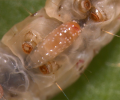
 Mature larva of B. brevicornis Mature larva of B. brevicornis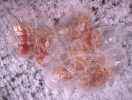 Pupae of B. brevicornis in silken cocoons Pupae of B. brevicornis in silken cocoons
DistributionCosmopolitan.
HostsAn extremely polyphagous ectoparasitoid, attacking Crambidae and Pyralidae in stored products and in the field; in the field other lepidopterous families may also be attacked (van Achterberg & Walker, 1998). Important hosts include Opisina arenosella (Walker), Chilo partellus (Swinhoe), Pectinophora gossypiella (Saunders); Corcyra cephalonica (Stainton) (factitious laboratory host, used widely for mass production in Indian insectaries).
Mass productionMass produced on the common laboratory host, Corcyra cephalonica (Stainton).
Singh (1995) has given the detailed production procedure for B. brevicornis and C. cephalonica.
References
Image creditThe line drawings are redrawn from van Achterberg and Walker (1998).
|
